| V Corps | |
|---|---|
| Active | 1950–present |
| Country | North Korea |
| Branch | Army |
| Type | infantry |
| Part of | Korean People's Army |
| Garrison/HQ | Sepo County, Kangwon Province |
| Engagements | Korean War |
The V Corps of the Korean People's Army was created before January 1951.
Consisted of at least 3 divisions on January 7, 1951, when 2 divisions assaulted the U.S. 2nd Infantry Division in a frontal attack, while a third division attacked from the northwest against the adjacent ROK 8th Division. They were assisted by one of the divisions of the NKPA II Corps, which also launched attacks against the neighboring ROK III Corps to the east. The North Koreans managed to force the 2nd Division out of Wonju by the evening of January 7, and all counterattacks failed to retake the city. [1]

The I Corps is a corps of the United States Army headquartered in Joint Base Lewis-McChord, Washington. It is a major formation of United States Army Pacific (USARPAC) and its current mission involves administrative oversight of army units in the Asia-Pacific region, including the Pacific Pathways program.
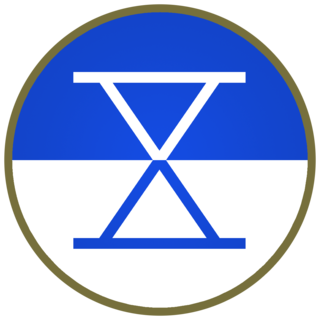
X Corps was a corps of the United States Army in World War II and the Korean War.

IX Corps was a corps of the United States Army. For most of its operational history, IX Corps was headquartered in or around Japan and subordinate to US Army commands in the Far East.

Operation Ripper, also known as the Fourth Battle of Seoul, was a United Nations (UN) military operation conceived by the US Eighth Army, General Matthew Ridgway, during the Korean War. The operation was intended to destroy as much as possible of the Chinese People's Volunteer Army (PVA) and Korean People's Army (KPA) forces around Seoul and the towns of Hongch'on, 50 miles (80 km) east of Seoul, and Chuncheon, 15 miles (24 km) further north. The operation also aimed to bring UN troops to the 38th Parallel. It followed upon the heels of Operation Killer, an eight-day UN offensive that concluded February 28, to push PVA/KPA forces north of the Han River. The operation was launched on 6 March 1951 with US I Corps and IX Corps on the west near Seoul and Hoengsong and US X Corps and Republic of Korea Army (ROK) III Corps in the east, to reach the Idaho Line, an arc with its apex just south of the 38th Parallel in South Korea.
The Battle of the Twin Tunnels took place during the Korean War. In which the UN forces inflicted heavy casualties on the People's Volunteer Army (PVA). The "Twin Tunnels" refer to a series of railroad tunnels along the Central Line in eastern Jije-myeon, Yangpyeong County, Gyeonggi Province, South Korea.
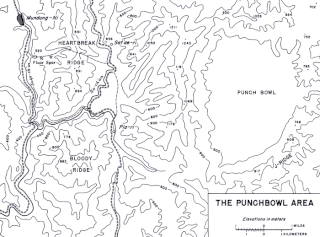
The Battle of Bloody Ridge was a ground combat battle that took place during the Korean War from 18 August to 5 September 1951.

The III Corps is a corps of the Republic of Korea Army that was formed on October 16, 1950. One of its commanders was Major General Yu Jae Hung.
The II Corps is a corps of the Korean People's Army. It was created on June 12, 1950 with Lt. General Kim Kwang-hyop in command. During the Korean War the unit was composed of the 2nd Infantry Division, the 5th Infantry Division, and the 12th Infantry Division.
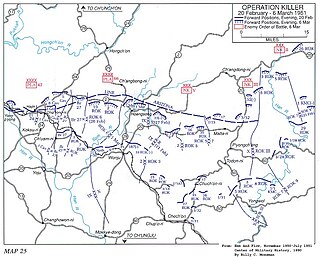
Operation Killer was a military operation that marked the start of the second major counter offensive which United Nations Command (UN) forces launched against the Chinese Communist People's Volunteer Army (PVA) and the North Korean Army (KPA) during the Korean War. The offensive lasted from 20 February to 6 March 1951 and was formulated by General Matthew Ridgway with the goal of annihilating enemy forces south of a line designated the Arizona Line. The operation was immediately followed by Operation Ripper.
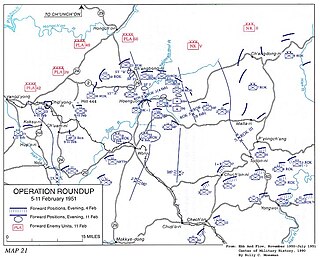
Operation Roundup was an advance by United Nations Command (UN) forces during the Korean War that took place from 5 to 11 February 1951. While achieving initial success against limited opposition, it was brought to a halt by Chinese People's Volunteer Army (PVA) and North Korean Korean People's Army (KPA) forces at the Battle of Hoengsong.

The 2nd Marine Infantry Division, also known as Blue Dragon Division or more literally the Aqua (color) Dragon Division, is an infantry division of the Republic of Korea Marine Corps.

The Battle of Onjong, also known as the Battle of Wenjing, was one of the first engagements between Chinese and South Korean forces during the Korean War. It took place around Onjong in present-day North Korea from 25 to 29 October 1950. As the main focus of the Chinese First Phase Offensive, the People's Volunteer Army (PVA) 40th Corps conducted a series of ambushes against the Republic of Korea Army (ROK) II Corps, effectively destroying the right flank of the United States Eighth Army while stopping the UN advance north toward the Yalu River.

The Battle of the Ch'ongch'on River, also known as the Battle of the Ch'ongch'on, was a decisive battle in the Korean War that took place from November 25 to December 2, 1950, along the Ch'ongch'on River Valley in the northwestern part of North Korea. In response to the successful Chinese First Phase Campaign against the United Nations (UN) forces, General Douglas MacArthur launched the Home-by-Christmas Offensive to expel the Chinese forces from Korea and to end the war. Anticipating this reaction, the Chinese People's Volunteer Army (PVA) Commander Peng Dehuai planned a counteroffensive, dubbed the "Second Phase Campaign", against the advancing UN forces.
The Battle of Kumsong, also known as the Jincheng Campaign, was one of the last battles of the Korean War. During the ceasefire negotiations seeking to end the Korean War, the United Nations Command (UNC) and Chinese and North Korean forces were unable to agree on the issue of prisoner repatriation. South Korean President Syngman Rhee, who refused to sign the armistice, released 27,000 North Korean prisoners who refused repatriation. This action caused an outrage among the Chinese and North Korean commands and threatened to derail the ongoing negotiations. As a result, the Chinese decided to launch an offensive aimed at the Kumsong salient. This would be the last large-scale Chinese offensive of the war, scoring a victory over the UNC forces.
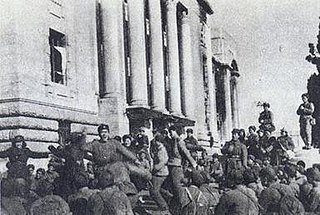
The Third Battle of Seoul was a battle of the Korean War, which took place from December 31, 1950, to January 7, 1951, around the South Korean capital of Seoul. It is also known as the Chinese New Year's Offensive, the January–Fourth Retreat or the Third Phase Campaign Western Sector.

The First and Second Battles of Wonju, also known as the Wonju Campaign or the Third Phase Campaign Eastern Sector, was a series of engagements between North Korean and United Nations (UN) forces during the Korean War. The battle took place from December 31, 1950, to January 20, 1951, around the South Korean town of Wonju. In coordination with the Chinese capture of Seoul on the western front, the North Korean Korean People's Army (KPA) attempted to capture Wonju in an effort to destabilize the UN defenses along the central and the eastern fronts.

The Chinese spring offensive, also known as the Chinese Fifth Phase Offensive, was a military operation conducted by the Chinese People's Volunteer Army (PVA) during the Korean War. Mobilizing three field armies totaling 700,000 men for the operation, the Chinese command conducted their largest offensive operation since their Second Phase Offensive in November and December 1950. The operation took place in the summer of 1951 and aimed at permanently driving the United Nations Command (UN) forces off the Korean peninsula.

Operation Dauntless was a military operation performed by the United Nations Command (UN) during the Korean War designed to advance the UN lines to positions 10–20 miles (16–32 km) north of the 38th Parallel designated the Wyoming Line which would threaten the Chinese and North Korean logistics hub marked out by the towns of Pyonggang, Ch'orwon and Gimhwa-eup named the Iron Triangle. The operation immediately succeeded Operation Rugged which took the UN forces to the Kansas Line 2 to 6 miles north of the 38th Parallel. The operation was initially successful, reaching its initial objectives, but was brought to a halt by the Chinese Spring Offensive on 22 April 1951.

The Battle of the Soyang River, also referred to as the "May Massacre", or Battle of Hyeon-ri in Korean and Chinese was fought during the Korean War between United Nations Command (UN) and the Chinese People's Volunteer Army (PVA) and Korean People's Army (KPA) during the Spring Offensive of April–May 1951. The attack took place across the entire front but with the main thrust below the Soyang River in the Taebaek Mountains. The objective of the main effort was to sever the six Republic of Korea Army (ROK) divisions on the eastern front from the remainder of the US Eighth Army and annihilate them and the US 2nd Infantry Division. Secondary attacks would be mounted by PVA and KPA forces across the entire front.

The Third Battle of Wonju, was a series of engagements between North Korean and United Nations (UN) forces during the Korean War. The battle took place from 13 to 18 February 1951 north of the South Korean town of Wonju.